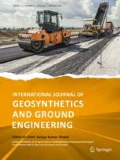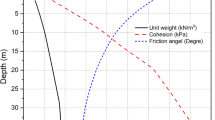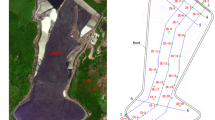Abstract
The paper presents the reliability-based approach to assess the performance of landfill considering uncertainties associated with the hydraulic properties of various components of the system. A model domain having final cover system and municipal solid waste (MSW) layer is considered as an integrated system for the analysis. Water balance is computed using the Hydrologic Evaluation of Landfill Performance (HELP) model to construct response surfaces for the reliability analysis. The probability of accumulation of leachate head \(({{h}_{ac}})\) at the bottom of the MSW layer above an allowable head \(({{h}_{al}})\) is considered as the criterion for reliability estimates in this study. The results of the analysis are discussed in terms of the reliability index, \(\beta\). The impact of variations in (a) hydraulic characteristics of the various layers (b) defects and placement conditions of geomembrane (GM) on the system performance have been studied. The results reveal that the hydraulic conductivity of compacted clay layer (CCL) of the cover component along with the porosity and saturated hydraulic conductivity of MSW layer are the significant parameters, which influence the reliability. Further, impact of model uncertainty and parametric analysis of significant variables are conducted and the results are discussed.












Similar content being viewed by others
References
Farquhar GJ (1989) Leachate: production and characterization. Can J Civ Eng 16(3):317–325
Koerner RM, Soong TY (2000) Leachate in landfills: the stability issues. Geotext Geomembr 18(5):293–309
USEPA (1993) Solid waste disposal facility criteria, subpart D-design criteria. U.S. Environmental Protection Agency, Washington EPA530-R-93-017, 40 CFR § 258.40
Koerner RM, Koerner JR (2008) Results of a worldwide regulatory survey on allowable hydraulic head within landfill sumps. GRI white paper no. 13, Geosynthetic Institute, Folsm, pp 1–12
Bogardi I, Kelly WE, Bardossy A (1989) Reliability model for soil liners: initial design. J Geotech Eng 115(5):658–669
Hosser D, Dehne M, Ahrens H, Kindlein J (2003) Modelling simplification of landfill processes by using methods of reliability theory. Waste Manage Res 21(2):119–126
Pivato A (2011) Landfill liner failure: an open question for landfill risk analysis. J Environ Protect 2(3):287–297
Schroeder PR, Dozier TS, Zappi PA, McEnroe BM, Sjostrom JW, Peton RL (1994) The hydrologic evaluation of landfill performance (HELP) model: engineering documentation for version 3.EPA/600/R-94/168b. U. S. Environmental Protection Agency, Risk Reduction Engineering Laboratory, Cincinnati, pp 1–110
São Mateus MDSC, Machado SL, Barbosa MC (2012) An attempt to perform water balance in a Brazilian municipal solid waste landfill. Waste Manage 32(3):471–481
Sivapullaiah PV, Lakshmi kantha H, Madhu Kiran K (2003) Geotechnical properties of stabilized Indian red earth. J Geotech Geol Eng 21(4):399–413
BabuSivakumar GL, Chouksey SK, Lakshmikanthan P (2012) Study of engineering properties of municipal solid waste of Bangalore city. Proceedings of Indian Geotechincal Conference, Advances in Geotechnical Engineering, vol. 1. Indian Institute of Technology Delhi, New Delhi, pp 779–782
Beaven RP, Powrie W (1995) Hydrogeological and geotechnical properties of refuse using a large scale compression cell. In: Christensen TH, Cossu R, Stegmann R (eds) Proceedings of the fifth international landfill symposium Sardinia’95, vol. 2. CISA, University of Cagliary, Italy, pp 745–760
Olivier F, Gourc JP (2007) Hydro-mechanical behavior of MSW subject to leachate recirculation in a large-scale compression reactor cell. Waste Manage (Oxford) 27(1):44–58
Staub MJ, Galietti B, Oxarango L, Khire MV, Gourc JP (2009) Porosity and hydraulic conductivity of MSW using laboratory scale tests. Proceedings of third international workshop on hydro–physic–mechanics of landfill, March 2009, Braunschweig, Germany
Dieleman PJ, Trafford OD (1976) Drainage testing; irrigation and drainage. Paper No. 28, Rome, Italy, pp. 172
Zhai H, Benson CH (2006) The log-normal distribution for hydraulic conductivity of compacted clays: two or three parameters? J Geotech Geol Eng 24(5):1149–1162
Williams KH (1989) Random nature of soil porosity and related properties. J Eng Mech 115(5):1129–1133
Schultze E (1972) Frequency distributions and correlations of soil properties. Applications of statistics and probability in civil engineering. Hong Kong University Press, (distributed by Oxford University Press, London
Babu, Sivakumar GL, Srivastava A (2010) Reliability analysis of earth dams. J Geotech Geoenviron Eng 136(7):995–998
Benson CH, Trast JM (1995) Hydraulic conductivity of thirteen compacted clays. Clay Clay Mineral 43(6):669–681
Peyton RL, Schroeder PR (1988) Field verification of HELP model for landfills. J Environ Eng 114(2):247–269
Stephens DB, Coons LM (1994) Landfill performance assessment at a semi arid site: modeling and validation. Groundwater Monitor Remediat 14(1):101–109
Berger K (2000) Validation of the hydrologic evaluation of landfill performance (HELP) model for simulating the water balance of cover systems. Environ Geol 39(11):1261–1274
Jang YS, Kim Y-W, Lee S-I (2002) Hydraulic properties and leachate level analysis of Kimpo metropolitan landfill, Korea. Waste Manage (Oxford) 22(3):261–267
Shariatmadari N, Abdoli MA, Ghiasinejad H, Alimohammadi P (2010) Assessment of HELP model performance in arid areas, case study: landfill test cells in Kahrizak. Res J Environ Sci 4(4):359–370
Alslaibi TM, Abustan I, Mogheir YK, Afifi S (2013) Quantification of leachate discharged to groundwater using the water balance method and the hydrologic evaluation of landfill performance (HELP) model. Waste Manage Res 31(1):50–59
Zhang WJ, Zhang GG, Chen Y (2013) Analyses on a high leachate mound in a landfill of municipal solid waste in China. Environ Earth Sci 70(4):1747–1752
Xie H, Chen Y, Lou Z (2010) An analytical solution to contaminant transport through composite liners with geomembrane defects. Sci China Technol Sci 53(5):1424–1433
Giroud JP (1997) Equations for calculating the rate of liquid migration through composite liners due to geomembrane defects. Geosyn Int 4(3–4):335–348
Touze-Foltz N, Rowe RK, Duquennoi C (1999) Liquid flow through composite liners due to geomembrane defects: analytical solutions for axi-symmetric and two-dimensional problems. Geosyn Int 6(6):455–479
Chai JC, Miura N, Hayashi S (2005) Large-scale tests for leachate flow through composite liner due to geomembrane defects. Geosyn Int 12(3):134–144
Saidi F, Touze-Foltz N, Goblet P(2008) Numerical modelling of advective flow through composite liners in case of two interacting adjacent square defects in the geomembrane. Geotext Geomembr 26(2):196–204
Rowe RK, Chappel MJ, Brachman RWI, Take WA (2012) Field study of wrinkles in a geomembrane at a composite liner test site. Can Geotech J 49(10):1196–1211
Chen Y, Wang Y, Xie H (2015) Breakthrough time-based design of landfill composite liners. Geotext Geomembr 43(2):196–206
Myers RH, Montgomery DC (2002) Response surface methodology. John Wiley and Sons. Inc., New York, pp 1–798
Hasofer AM, Lind NC (1974) Exact and invariant second-moment code format. J Eng Mech 100(1):111–121
Low BK, Tang WH (1997) Efficient reliability evaluation using spreadsheet. J Eng Mech 123(7):749–752
USACE (1997) Risk-based analysis in geotechnical engineering for support of planning studies, engineering and design. U.S. Army Corps of Engineers, Washington
Giroud JP, Bonaparte R (1989) Leakage through liners constructed with geomembranes-Part II. Geomembrane liners. Geotext Geomembr 8(2):71–111
Acknowledgements
The study presented is a part of research in the project CIST/MCV/GLS/0038 “Evaluation of Municipal Solid Waste (MSW) characteristics of a typical landfill in Bangalore” funded by Centre for infrastructure, Sustainable Transportation and Urban Planning (CiSTUP), which is greatly acknowledged. The authors thank Mr. Anthony A, for helping in conducting the experiments.
Author information
Authors and Affiliations
Corresponding author
Rights and permissions
About this article
Cite this article
Santhosh, L.G., Lakshmikanthan, P. & Babu, G.L.S. Reliability Based Approach for the Prediction of Leachate Head in MSW Landfills. Int. J. of Geosynth. and Ground Eng. 3, 4 (2017). https://doi.org/10.1007/s40891-016-0080-4
Received:
Accepted:
Published:
DOI: https://doi.org/10.1007/s40891-016-0080-4




